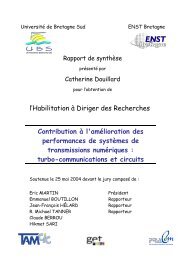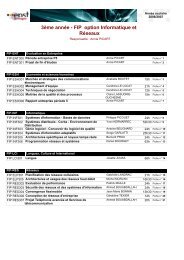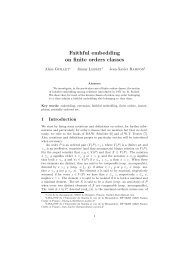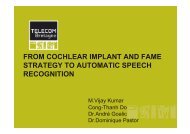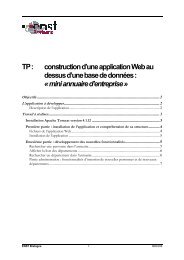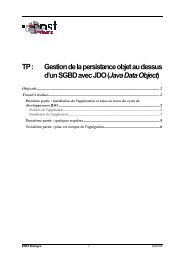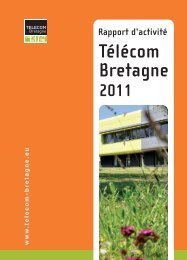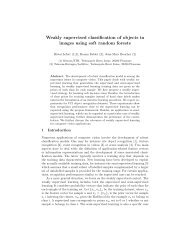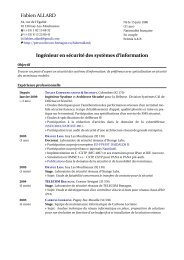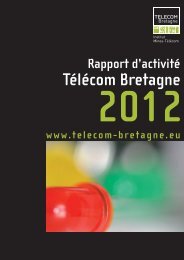researResearch - Télécom Bretagne
researResearch - Télécom Bretagne
researResearch - Télécom Bretagne
You also want an ePaper? Increase the reach of your titles
YUMPU automatically turns print PDFs into web optimized ePapers that Google loves.
h Research<br />
9<br />
RESEARCH<br />
a needs analysis of project-based pedagogy, it<br />
appears that collaborative and cooperative<br />
learning modes are the foundation of the<br />
pedagogic challenges. Integrating all the rich<br />
new technological developments in pervasive<br />
computing now allows us to envisage mobile<br />
learning as a concrete application of the theories<br />
of situated learning. Moreover, we hope that this<br />
research will have a concrete impact on<br />
improving the quality of our teaching practice.<br />
Semantic information systems<br />
This theme was developed in the "GET<br />
semantics" project, financed by the Telecom<br />
Foundation. The subject is the design of a<br />
semantic information system to manage<br />
research in the Telecom Institute. This is based<br />
on semantic web technologies. The aim is to<br />
organise and structure different categories of<br />
information connected to research and to the<br />
organisation of our institute. The different<br />
categories of information are specifically : the<br />
schools, the departments, the defining projects,<br />
the people, competences, etc. This information is<br />
structured according to different grids of analysis<br />
or classifications which organise and allow<br />
« indexing » : activity areas, activity programmes,<br />
sectors, systems, disciplines and aspects.<br />
Several ontologies representing the organisation<br />
of the institute, the categories of people, the<br />
defining projects and the classifications have<br />
been developed. The corresponding data, present<br />
in the institute's information system, have been<br />
integrated into our semantic information system<br />
demonstrator.<br />
Access to the semantic information system is<br />
gained through a web site based on<br />
environments and tools such as Tomcat, Servlet,<br />
Jsp and Ajax, along with a knowledgemanagement<br />
system called Ontobroker. The<br />
latter allows the management of ontologies and<br />
of the triple « RDF » corresponding to the data<br />
coming from the institute's current information<br />
system. This site is structured using the<br />
information categories available, grids of<br />
analysis and a prototypical typology of<br />
information search activities – which are not<br />
exhaustive, but representative of the possibilities<br />
offered by these types of environments and<br />
technologies. The methodology of semantic<br />
information system design from ontologies and<br />
object models – for the interaction components<br />
– allows the extension and simplified<br />
maintenance of the system.<br />
Thematic virtual museum<br />
For some years, SCRIPtureS has been involved in<br />
the theme of cultural heritage. The development<br />
of a thematic virtual museum (on the theme of<br />
the Annunciation) is now a reality<br />
(www.annunciation.gr) ; the Greek version , as<br />
the project was carried out with Greek partners,<br />
within the framework of a national project ; the<br />
English version is under development. This is<br />
probably a rare, possibly unique, case worldwide<br />
(typically current virtual museums are<br />
showcases for museums which already in<br />
existence; thematic virtual museums are not<br />
easily found on the WEB). The virtual museum we<br />
have developed takes up the research questions<br />
which are at the heart of the SCRIPtureS project :<br />
domain ontologies ( byzantine painting : some<br />
30000 concepts indexed), indexing and semantic<br />
information search, contextualisation and<br />
adaptation to a variety of types of visitor, multiscenario<br />
development of navigation through the<br />
works, readings at different levels etc., extends<br />
to questions of ergonomy, and develops<br />
Human/Machine interaction to a level where the<br />
amateur and the art historian can coexist<br />
without exclusion, through interfaces which give<br />
a view of the structure in a very intuitive way. On<br />
the other hand, it can implement three history of<br />
art teaching models (the work seen from a<br />
distance, studied through its details or as an<br />
element of a larger collection). Through this, the<br />
research question of the virtual museum is that<br />
of CEHL (the visit is only a journey and finally an<br />
oblique lesson, only it is the visitor who organises<br />
his or her navigation). SCRIPtureS intends to<br />
continue this activity which already appears to be<br />
attracting interest from culture professionals.<br />
163



